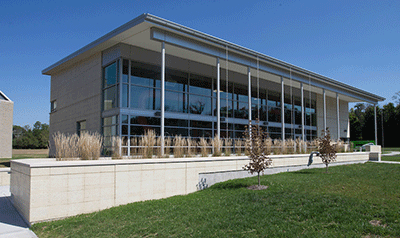
Geothermal comes to Hoyt Hall

Miami's geothermal plant.
By Cathy McVey, information technology services
If you have ventured to Western campus this summer you are aware of the commotion and upheaval going on. Travel to and from Hoyt Hall, home of IT services’ main offices, can be a bit of a challenge.
One ongoing project has disrupted traffic around Hoyt and Presser halls, has closed sidewalks, and includes work that may impede mobility inside Hoyt for a short time. What work requires such a ruckus? Physical facilities is tying the building to the geothermal system which will provide nearly all of Hoyt’s heating and cooling needs.
Why Hoyt Hall?
According to Doug Hammerle, director of energy systems, “Hoyt has the number one cost per gross square foot of the state buildings on Oxford’s campus.”
What makes Hoyt such an “energy hog”?
It is the home of Miami’s primary data center and data centers are fussy about things like temperature, humidity and dust. If the balance of those factors gets out of whack there is a real risk of static buildup or flat-out failure.
A lot of servers in an enclosed space generate a significant amount of heat, meaning that the data center’s AC runs 24/7 year-round. Part of the project allows that “server heat” to be captured and either used to meet the university’s current energy needs or stored in the ground until it’s needed.
Dave Beitz, manager of data center operations, is thrilled with the new arrangement. “We have a lot of equipment that act like little space heaters. If it gets too hot things start breaking down,” explains Beitz. “Being tied to the geothermal system should make our temperature management more stable.”
This change not only affects the data center. Since the heating and cooling for most of the building is changing, physical facilities staff need to access the heating and cooling equipment in other areas, too. Some offices on the third floor will be disrupted for a short time while desks, file cabinets and other furniture are moved to provide access to radiators. Ladders are popping up in hallways as physical facilities staff works on the overhead piping.
According to Beth Farthing Moore, senior director of IT process, planning and administration, “Only about 10 IT staff will be displaced and our neighbors, career services, have offered short term space, and that will minimize the impact. As a result, we can count on more consistent and comfortable temperatures throughout the building in both summer and winter.”
Geothermal system to help reduce energy costs
So, once this work is done, does that mean there will be no energy costs to run the data center? Hammerle is quick to stop that notion, “No, geothermal doesn’t eliminate energy costs – but it will significantly reduce them. Geothermal provides the heating and cooling, but the electric power to run the servers, lights and other equipment from computers to pencil sharpeners is still needed.”
Hammerle also points out that the reduction of waste through the recapture of excess heating is closely aligned with Miami’s LEAN goals. Beitz and Hammerle both emphasized that this move will not impact any of the existing systems for backup power in case of an emergency.
Although this project has certainly been disruptive in the short run, it will pay big benefits in the long run. Those benefits will be measured in actual energy dollars saved, cleaner energy gaining a wider footprint on campus, a more stable cooling system for the data center, and a more comfortable work environment for IT and career staff.
Interested in learning more about geothermal? Check out the following web resources: Geothermal Energy Association and Union of Concerned Scientists.
